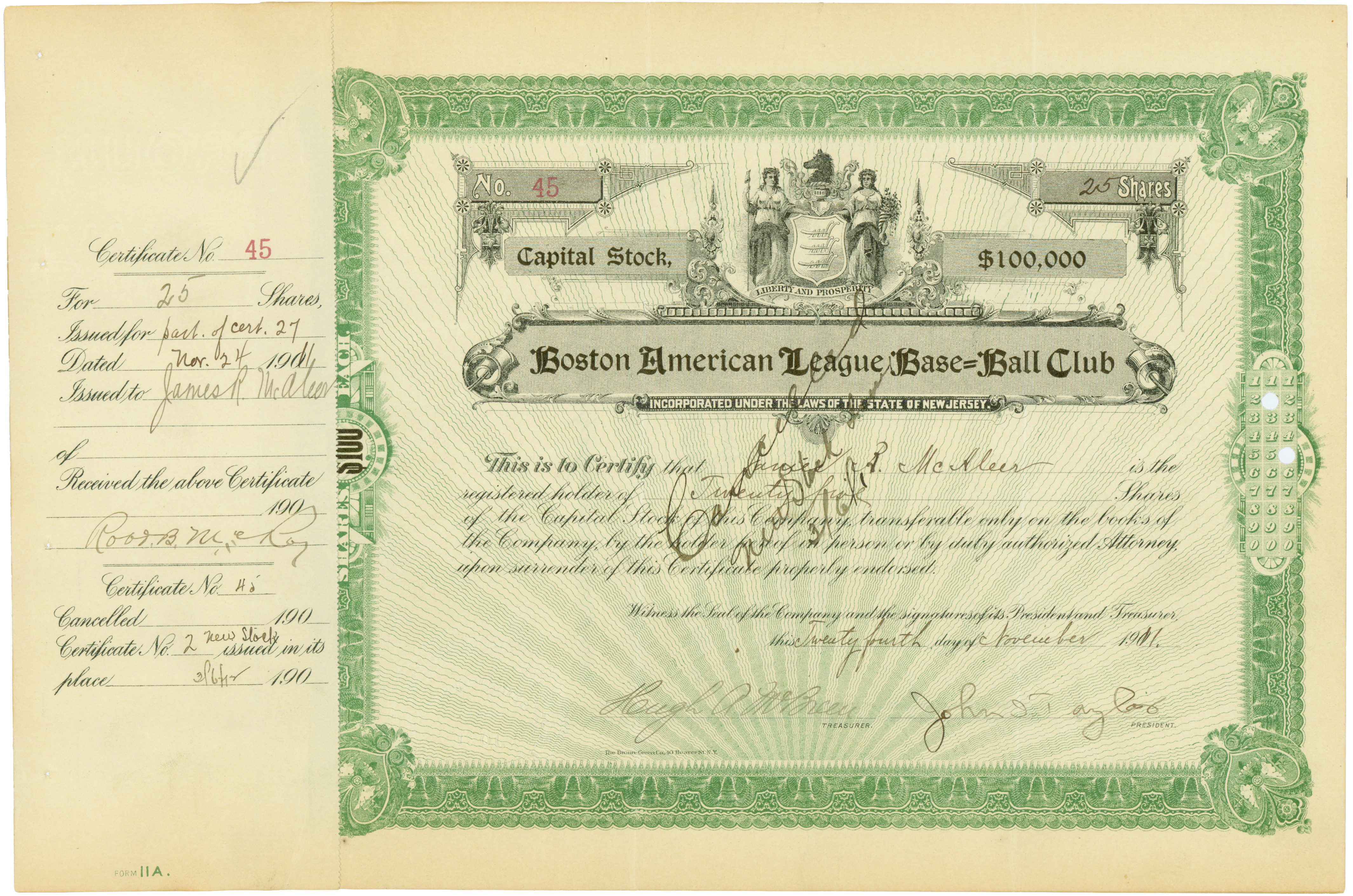|
Paid-in Capital
Paid-in capital (also paid-up capital and contributed capital) is capital that is contributed to a corporation by investors by purchase of stock from the corporation, the primary market, not by purchase of stock in the open market from other stockholders (the secondary market). It includes share capital (capital stock) as well as additional paid-in capital. The paid-in capital account does not reflect the amount of capital contributed by any specific investor. Instead, it shows the aggregate amount of capital contributed by all investors. However, the term has different definitions in different contexts. For example, it could refer to the money that a company gets from potential investors, in addition to the stated (nominal or par) value of the stock, which coincides with the definition of additional paid-in capital, or paid-in capital in excess of par. One should be aware of the use of the term and the abbreviation, which can confuse. See also * Balance sheet * ... [...More Info...] [...Related Items...] OR: [Wikipedia] [Google] [Baidu] |
Financial Capital
Financial capital (also simply known as capital or equity in finance, accounting and economics) is any Economic resources, economic resource measured in terms of money used by entrepreneurs and businesses to buy what they need to make their products or to provide their services to the sector of the economy upon which their operation is based (e.g. retail, corporate, investment banking). In other words, financial capital is internal retained earnings generated by the entity or funds provided by lenders (and Investor, investors) to businesses in order to purchase real capital equipment or services for producing new Goods and services, goods or services. In contrast, real capital comprises physical goods that assist in the production of other goods and services (e.g. shovels for gravediggers, sewing machines for tailors, or machinery and tooling for factories). IFRS concepts of capital maintenance ''Financial capital'' generally refers to saved-up financial Wealth (economics), we ... [...More Info...] [...Related Items...] OR: [Wikipedia] [Google] [Baidu] |
Investor
An investor is a person who allocates financial capital with the expectation of a future Return on capital, return (profit) or to gain an advantage (interest). Through this allocated capital the investor usually purchases some species of property. Types of investments include Stock, equity, Bond (finance), debt, Security (finance), securities, real estate, infrastructure, currency, commodity, Exonumia, token, derivatives such as put and call Option (finance), options, Futures contract, futures, Forward contract, forwards, etc. This definition makes no distinction between the investors in the Primary market, primary and secondary markets. That is, someone who provides a business with capital and someone who buys a stock are both investors. An investor who owns stock is a shareholder. Types of investors There are two types of investors: retail investors and institutional investors. A ''retail investor'' is also known as an ''individual investor''. There are several sub-typ ... [...More Info...] [...Related Items...] OR: [Wikipedia] [Google] [Baidu] |
Primary Market
The primary market is the part of the capital market that deals with the issuance and sale of securities to purchasers directly by the issuer, with the issuer being paid the proceeds. A primary market means the market for new issues of securities, as distinguished from the secondary market, where previously issued securities are bought and sold. A market is primary if the proceeds of sales go to the issuer of the securities sold. Buyers buy securities that were not previously traded. Concept In a primary market, companies, governments, or public sector institutions can raise funds through bond issues, and corporations can raise capital through the sale of new stock through an initial public offering (IPO). This is often done through an investment bank or underwriter or finance syndicate of securities dealers. The process of selling new shares to buyers is called underwriting. Dealers earn a commission that is commonly built into the price of the security offering, though it ... [...More Info...] [...Related Items...] OR: [Wikipedia] [Google] [Baidu] |
Secondary Market
The secondary market, also called the aftermarket and follow on public offering, is the financial market in which previously issued financial instruments such as stock, bonds, options, and futures are bought and sold. The initial sale of the security by the issuer to a purchaser, who pays proceeds to the issuer, is the primary market. All sales after the initial sale of the security are sales in the secondary market. Whereas the term primary market refers to the market for new issues of securities, and " market is primary if the proceeds of sales go to the issuer of the securities sold," the secondary market in contrast is the market created by the later trading of such securities. With primary issuances of securities or financial instruments (the primary market), often an underwriter purchases these securities directly from issuers, such as corporations issuing shares in an initial public offering (IPO) or private placement. Then the underwriter re-sells the securi ... [...More Info...] [...Related Items...] OR: [Wikipedia] [Google] [Baidu] |
Share Capital
A corporation's share capital, commonly referred to as capital stock in the United States, is the portion of a corporation's equity that has been derived by the issue of shares in the corporation to a shareholder, usually for cash. ''Share capital'' may also denote the number and types of shares that compose a corporation's share structure. Definition In accounting, the share capital of a corporation is the nominal value of issued shares (that is, the sum of their par values, sometimes indicated on share certificates). If the allocation price of shares is greater than the par value, as in a rights issue, the shares are said to be sold at a premium (variously called share premium, additional paid-in capital or paid-in capital in excess of par). This equation shows the constituents that make up a company's real share capital: : \sum\text \times \text This is differentiated from share capital in the accounting sense, as it presents nominal share capital and does not take t ... [...More Info...] [...Related Items...] OR: [Wikipedia] [Google] [Baidu] |
Additional Paid-in Capital
Capital surplus, also called share premium, is an account which may appear on a corporation's balance sheet, as a component of shareholders' equity, which represents the amount the corporation raises on the issue of shares in excess of their par value (nominal value) of the shares (common stock). This is called Additional paid in capital in US GAAP terminology but, additional paid in capital is not limited to share premium. It is a very broad concept and includes tax related and conversion related adjustments. Taken together, common stock (and sometimes preferred stock) issued and paid (plus capital surplus) represent the total amount actually paid by investors for shares when issued (assuming no subsequent adjustments or changes). Shares for which there is no par value will generally not have any form of capital surplus on the balance sheet; all funds from issuing shares will be credited to common stock issued. Some other scenarios for triggering a capital surplus include when ... [...More Info...] [...Related Items...] OR: [Wikipedia] [Google] [Baidu] |
Balance Sheet
In financial accounting, a balance sheet (also known as statement of financial position or statement of financial condition) is a summary of the financial balances of an individual or organization, whether it be a sole proprietorship, a business partnership, a corporation, private limited company or other organization such as government or not-for-profit entity. Assets, liabilities and ownership equity are listed as of a specific date, such as the end of its financial year. A balance sheet is often described as a "snapshot of a company's financial condition". It is the summary of each and every financial statement of an organization. Of the four basic financial statements, the balance sheet is the only statement which applies to a single point in time of a business's calendar year. A standard company balance sheet has two sides: assets on the left, and financing on the right–which itself has two parts; liabilities and ownership equity. The main categories of assets are ... [...More Info...] [...Related Items...] OR: [Wikipedia] [Google] [Baidu] |
Capital Surplus
Capital surplus, also called share premium, is an account which may appear on a corporation's balance sheet, as a component of shareholders' equity, which represents the amount the corporation raises on the issue of shares in excess of their par value (nominal value) of the shares (common stock). This is called Additional paid in capital in US GAAP terminology but, additional paid in capital is not limited to share premium. It is a very broad concept and includes tax related and conversion related adjustments. Taken together, common stock (and sometimes preferred stock) issued and paid (plus capital surplus) represent the total amount actually paid by investors for shares when issued (assuming no subsequent adjustments or changes). Shares for which there is no par value will generally not have any form of capital surplus on the balance sheet; all funds from issuing shares will be credited to common stock issued. Some other scenarios for triggering a capital surplus include when ... [...More Info...] [...Related Items...] OR: [Wikipedia] [Google] [Baidu] |
Preferred Stock
Preferred stock (also called preferred shares, preference shares, or simply preferreds) is a component of share capital that may have any combination of features not possessed by common stock, including properties of both an equity and a debt instrument, and is generally considered a hybrid instrument. Preferred stocks are senior (i.e., higher ranking) to common stock but subordinate to bonds in terms of claim (or rights to their share of the assets of the company, given that such assets are payable to the returnee stock bond) and may have priority over common stock (ordinary shares) in the payment of dividends and upon liquidation. Terms of the preferred stock are described in the issuing company's articles of association or articles of incorporation. Like bonds, preferred stocks are rated by major credit rating agencies. Their ratings are generally lower than those of bonds, because preferred dividends do not carry the same guarantees as interest payments from bonds, and becau ... [...More Info...] [...Related Items...] OR: [Wikipedia] [Google] [Baidu] |
Reserve (accounting)
In financial accounting, reserve always has a credit balance and can refer to a part of shareholders' equity, a liability for estimated claims, or contra-asset for uncollectible accounts. A reserve can appear in any part of shareholders' equity except for contributed or basic share capital. In nonprofit accounting, an "operating reserve" is the unrestricted cash on hand available to sustain an organization, and nonprofit boards usually specify a target of maintaining several months of operating cash or a percentage of their annual income, called an operating reserve ratio. Types of reserves in accounting treatment There are different types of reserves used in financial accounting, including capital reserves, revenue reserves, statutory reserves, realized reserves, unrealized reserves. Equity ''reserves'' are created from several possible sources: * Reserves created from shareholders' contributions, the most common examples of which are: ** ''legal reserve fund'' – it is requ ... [...More Info...] [...Related Items...] OR: [Wikipedia] [Google] [Baidu] |
Treasury Stock
A treasury stock or reacquired stock is stock which is bought back by the issuing company, reducing the amount of outstanding stock on the open market ("open market" including insiders' holdings). Stock repurchases are used as a tax efficient method to put cash into shareholders' hands, rather than paying dividends, in jurisdictions that treat capital gains more favorably. Sometimes, companies repurchase their stock when they feel that it is undervalued on the open market. Other times, companies repurchase their stock to reduce dilution from incentive compensation plans for employees. Another reason for stock repurchase is to protect the company against a takeover threat.Robert T. Sprouse, "Accounting for treasury stock transactions: Prevailing practices and new statutory provisions." ''Columbia Law Review'' 59.6 (1959): 882-900online/ref> The United Kingdom equivalent of treasury stock as used in the United States is treasury share. Treasury stocks in the UK refers to gover ... [...More Info...] [...Related Items...] OR: [Wikipedia] [Google] [Baidu] |

